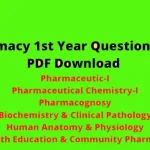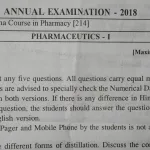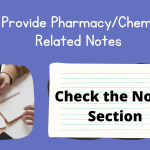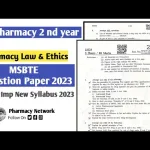D Pharmacy 2nd year students require comprehensive preparation for their exams. Understanding question patterns and answers across all subjects helps in better learning and performance.
Pharmaceutics II
Question: What are the objectives of preformulation studies?
Answer: Preformulation studies aim to understand the physical and chemical properties of a drug substance to develop a stable and effective dosage form.
Question: Define the term bioavailability.
Answer: Bioavailability is the rate and extent to which the active ingredient is absorbed and becomes available at the site of action.
Question: Explain the factors affecting dissolution rate.
Answer: Factors include particle size, surface area, solubility, temperature, and agitation rate during dissolution.
Question: What is the significance of sustained-release formulations?
Answer: Sustained-release formulations help maintain therapeutic drug levels for an extended period, improving patient compliance.
Question: List the different methods of tablet manufacturing.
Answer: The methods include wet granulation, dry granulation, and direct compression.
Question: How are emulsions stabilized?
Answer: Emulsions are stabilized by adding emulsifying agents that reduce interfacial tension and form a barrier around droplets.
Question: What is microencapsulation?
Answer: Microencapsulation is a process in which tiny particles or droplets are coated with a protective layer to improve stability or release characteristics.
Question: Describe the role of preservatives in pharmaceutical formulations.
Answer: Preservatives prevent microbial contamination, ensuring the safety and shelf life of the product.
Question: What are the advantages of aerosols as a dosage form?
Answer: Aerosols provide uniform dosing, rapid action, and convenience in use, especially for respiratory conditions.
Question: Define osmotic-controlled drug delivery system.
Answer: It is a system where drug release is controlled by osmotic pressure across a semi-permeable membrane.
Question: What are granules?
Answer: Granules are agglomerates of powdered materials, often used as intermediates for tablet manufacturing.
Question: How does particle size influence drug dissolution?
Answer: Smaller particle size increases surface area, enhancing dissolution and absorption.
Question: Explain the term ‘effervescent tablets.’
Answer: Effervescent tablets dissolve in water, releasing carbon dioxide to produce a fizzy solution for oral administration.
Question: What are pharmaceutical aerosols?
Answer: Aerosols are pressurized dosage forms containing active ingredients dispersed in a gas or liquid medium.
Question: Define shelf life of a drug product.
Answer: Shelf life is the time during which a drug maintains its specified potency and safety under recommended storage conditions.
Question: What are suppositories?
Answer: Suppositories are solid dosage forms intended for insertion into body cavities where they dissolve or melt.
Question: Discuss the importance of disintegration time in tablets.
Answer: Disintegration time indicates how quickly a tablet breaks down in the gastrointestinal tract, affecting drug absorption.
Question: How do coating materials improve tablet stability?
Answer: Coating materials protect tablets from moisture, light, and air, enhancing stability and shelf life.
Question: What are the types of emulsifying agents?
Answer: Types include natural agents (e.g., acacia), synthetic agents (e.g., polysorbates), and finely divided solids (e.g., bentonite).
Pharmacology II
Question: What is pharmacodynamics?
Answer: Pharmacodynamics is the study of how drugs interact with biological systems to produce effects.
Question: Define therapeutic index.
Answer: Therapeutic index is the ratio of a drug’s toxic dose to its effective dose, indicating safety.
Question: What is the mechanism of action of beta-blockers?
Answer: Beta-blockers block beta-adrenergic receptors, reducing heart rate and blood pressure.
Question: Explain the role of diuretics.
Answer: Diuretics increase urine production, helping manage conditions like hypertension and edema.
Question: What are antipyretics?
Answer: Antipyretics are drugs used to reduce fever by acting on the hypothalamus to dissipate heat.
Question: Describe the mechanism of action of NSAIDs.
Answer: NSAIDs inhibit cyclooxygenase enzymes, reducing the production of prostaglandins responsible for pain and inflammation.
Question: What is the pharmacological classification of insulin?
Answer: Insulin is classified as an anti-diabetic agent used to regulate blood glucose levels.
Question: What are antacids?
Answer: Antacids neutralize stomach acid, providing relief from indigestion and heartburn.
Question: Define drug tolerance.
Answer: Drug tolerance is a reduced response to a drug after repeated use, requiring higher doses for the same effect.
Question: What are the types of drug interactions?
Answer: Types include synergism, antagonism, and pharmacokinetic and pharmacodynamic interactions.
Question: Discuss the pharmacology of adrenaline.
Answer: Adrenaline acts on alpha and beta receptors, causing vasoconstriction, bronchodilation, and increased heart rate.
Question: What is drug metabolism?
Answer: Drug metabolism involves chemical alterations of drugs in the body, primarily in the liver, to enhance excretion.
Question: Explain first-pass metabolism.
Answer: It is the initial metabolism of a drug in the liver, reducing its bioavailability before reaching systemic circulation.
Question: What are sedatives?
Answer: Sedatives are drugs that calm the central nervous system, reducing anxiety and inducing sleep.
Question: What is the difference between bactericidal and bacteriostatic drugs?
Answer: Bactericidal drugs kill bacteria, while bacteriostatic drugs inhibit bacterial growth.
Question: Define receptor in pharmacology.
Answer: A receptor is a protein molecule that binds a drug, initiating a cellular response.
Question: What is an antidote?
Answer: An antidote is a substance that counteracts the toxic effects of a poison or drug overdose.
Question: Explain the pharmacological effects of atropine.
Answer: Atropine blocks muscarinic receptors, causing pupil dilation, reduced secretions, and increased heart rate.
Question: What are local anesthetics?
Answer: Local anesthetics are drugs that block nerve conduction in a specific area, providing temporary pain relief.
Question: How do antihypertensive drugs work?
Answer: Antihypertensive drugs lower blood pressure through mechanisms such as vasodilation, reduced heart rate, or decreased fluid retention.
Pharmaceutical Chemistry II
… [Continue similar structure for other subjects like Pharmaceutical Chemistry II, Hospital & Clinical Pharmacy, etc.]
D Pharmacy 2nd year students benefit from understanding the pattern and types of questions in their exams. With detailed answers provided for all subjects, this guide aids in efficient preparation and conceptual clarity.
Latest Posts
- Step-by-step guide to download and apply for jee mains admit card 202
- Comprehensive 2025 government holidays and recruitment details for job seekers
- JEE Mains Admit Card 2025: Your Step-by-Step Guide to Downloading the Hall Ticket
- Everything You Need to Know About 2025 Government Holidays Recruitment
- Comprehensive Guide to rrb d group recruitment 2025 – Eligibility, Vacancies, and Application
- Detailed guide to nps trust recruitment 2025 vacancies, eligibility and apply process
- Comprehensive guide to hpcl recruitment 2025 notification, vacancies, and application process
- ignou bed admission 2025 complete recruitment guide with eligibility and process
- Comprehensive Guide to Indian Army Agniveer Recruitment 2025 Notification and Jobs
- Everything You Must Know About CBSE Board Exams 2025 Changes & New Rules






